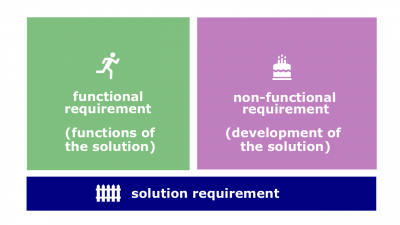Solution requirement
Solution requirement (hereinafter, the Requirement) is a characteristic of a solution that meets the business and stakeholder requirements. May be subdivided into functional and non-functional requirements.
Definitions
According to the BABOK Guide (3rd edition),
- Solution requirement. A capability or quality of a solution that meets the stakeholder requirements. Solution requirements can be divided into two sub-categories]]. functional requirements and non-functional requirements or quality of service requirements.
Types
- Functional requirement. Any requirement that refers to the market exchangeable capabilities. In other words, a functional requirement describes what the product must do for its users. In systems engineering, a functional requirement is a particular behavior or metric to judge the operation of a system.
- Non-functional requirement(s). The quality attributes, design and implementation constraints, and external interfaces that the product must have.
- Technical requirement. A set of technical properties that a product must fulfill.
- Transition requirement(s). A classification of requirements that describe capabilities that the solution must have in order to facilitate transition from the current state of the enterprise to the desired future state, but that will not be needed once that transition is complete.
Draft descriptions
functional--
- Usually detailed statements of capabilities, behavior, and information that the solution will need. Examples include formatting text, calculating a number, modulating a signal. They are also sometimes known as capabilities.
NFR--
- Usually detailed statements of the conditions under which the solution must remain effective, qualities that the solution must have, or constraints within which it must operate. Examples include: reliability, testability, maintainability, availability. They are also known as characteristics, constraints or the ilities.
Solution Requirements describe what characteristics a solution will have to meet the needs of the stakeholders and business. Similar to how multiple scenarios of stakeholder requirements could satisfy a business requirement, hence the need to translate and trace stakeholder requirements to business requirements, also multiple scenarios of solution requirements could satisfy a stakeholder requirement, hence the need to translate and trace stakeholder requirements to solution requirements. A few key points:
Solution Requirements describe WHAT characteristics the solution will support. From a stakeholder perspective the Solution Requirements may be viewed as describing HOW the Solution Requirements will meet the stakeholder need, but even from this perspective it would define the HOW logically and at a high level rather than give details of the implementation of the solution
Solution Requirements can be further categorized into:
Functional Requirements which describe the behavior of the solution and the information managed. In the case of a system, these are the features and functions of the system. Non-Functional Requirements define the qualities of the solution or the environmental conditions under which the solution will remain effective. In terms of a technical system solution this often refers to characteristics of capacity, speed, security, availability, etc.
These requirements refer to the expected features and behaviour of the system. Solution requirements as per BABOK guide:
Describe the capabilities and qualities of a solution that meets the stakeholder requirements. They provide the appropriate level of detail to allow for the development and implementation of the solution.
Solution requirements represent the requirements of a solution. These requirements will be used by the development team to develop the system. Solution requirements are of two types:
Functional requirements: Functional requirements are the expected features of the system. Features like registering a user, making an online purchase etc. Non-Functional requirements: Non-functional requirements are the requirements which are related to the behaviour of the system. Every page should load in 5 seconds is an example of non-functional requirement.
Features and characteristics expected of developed software application represent solution requirements.
Solution requirements are the most detailed type of requirements found in the standard. They describe the solution characteristics that will be needed to meet the higher-level business and stakeholder requirements. Typically, solution requirements are subdivided into three types: functional, non-functional and transition requirements.
Functional requirements define the capabilities that a product must provide to its users while non-functional requirements describe quality attributes, design and implementation constraints and external interfaces that the product must have.
Solution requirements : describe the capabilities and qualities of a solution that meets the stakeholder requirements. They provide the appropriate l of detail to allow for the development and implementation of the solut i evel . on Solution requirements can be divided into two sub-categories:
- functional requirements : describe the capabilities that a solution must have in terms of the behaviour and information that the solution will manage, and
- non-functional requirements or quality of service requirements : do not relate directly to the behaviour of functionality of the solution, but rather describe conditions under which a solution must remain effective or qualities that a solution must have.
Related concepts
- Business requirement. A higher level business rationale that, when addressed, will permit the organization to increase revenue, avoid costs, improve service, or meet regulatory requirements.
